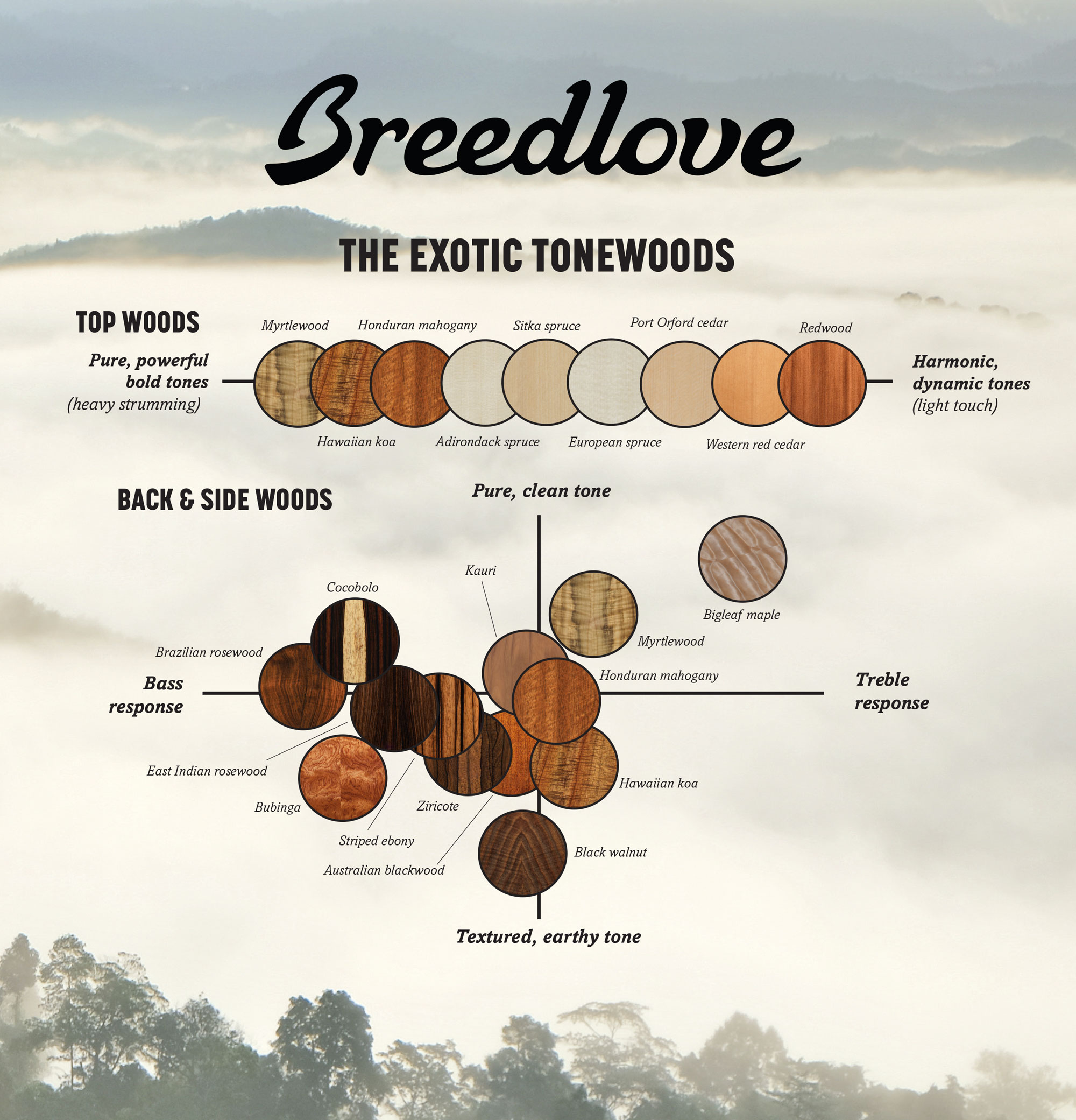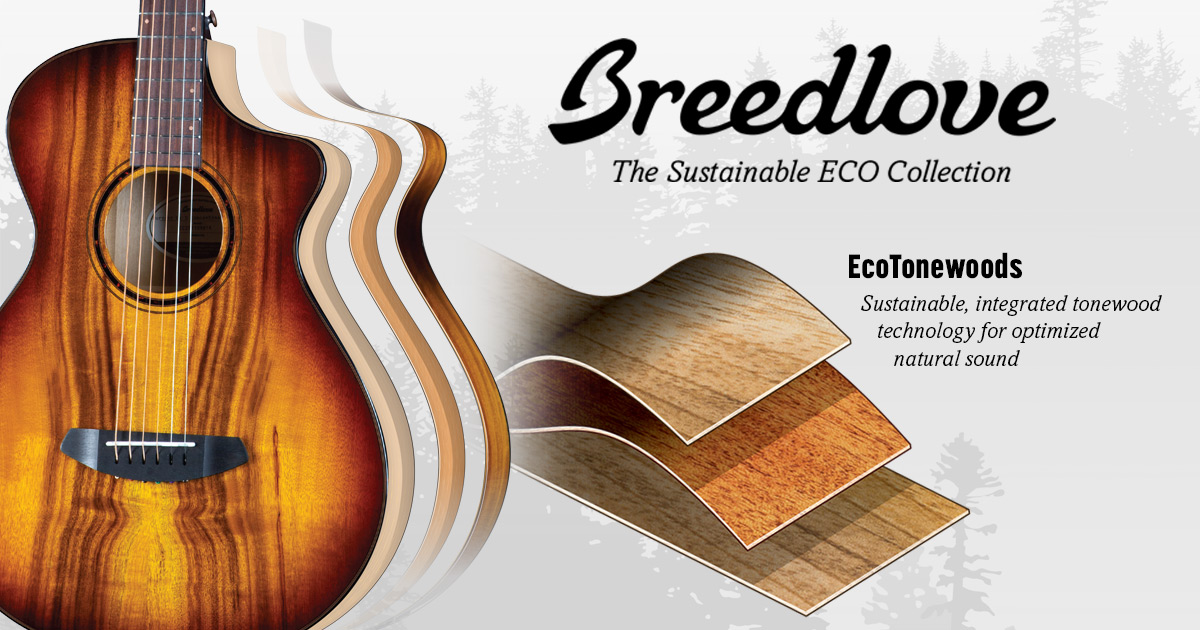 Tonewood is one of the guitar universe’s most discussed yet misunderstood topics. “Does tonewood matter?” “What is the best tonewood?” “What IS tonewood?” We get these questions all of the time. And with so much misinformation out there, it’s no wonder.
Tonewood is one of the guitar universe’s most discussed yet misunderstood topics. “Does tonewood matter?” “What is the best tonewood?” “What IS tonewood?” We get these questions all of the time. And with so much misinformation out there, it’s no wonder.
To clarify the waters a bit, (or muddy, depending on how you look at it), we thought we’d discuss the realities of how tonewood impacts your sound. The first thing to address is that, yes, tonewood matters, especially with acoustic guitars. But there’s a whole lot more to it.
Tonewood Species
It may come as a surprise, but there are no species of wood called tonewood. It’s a loose classification we’ve all given to a relatively small list of woods often used in guitar building. For acoustic guitars, this list includes many standard woods such as maple, mahogany, rosewood, spruce, and exotic options like our favorite, Myrtlewood. Here’s a quick rundown of the generally accepted tonal qualities of each.
Spruce
Spruce delivers a clear, defined, and balanced tone. This balance, combined with its ability to project with plenty of sonic power, makes it the undisputed favorite for acoustic guitar tops. But not all spruce is the same. Each type has its own take on these sonic qualities. While we use a lot of specialized spruce in the Breedlove Custom Shop, our go-to spruce types are either Adirondack, European, or Sitka. You can read more about each here.
Mahogany
Mahogany is a wonderful all-around acoustic guitar tonewood. Extremely even-sounding with a focus in the midrange, mahogany is a favorite of countless singer-songwriters and players wanting a warm, folky sound. Often found as a guitar’s back and sides, it also makes a great-sounding acoustic soundboard, as you’ll see on our Organic Pro Wildwood and Rainforest S series. You can read more about mahogany in this comprehensive article.
Rosewood
Rosewood is all about power and bell-like definition; that’s why it’s the go-to option for bluegrass guitarists and players who want their acoustic to cut through the mix. From the most desirable vintage flat-tops to the finest classical and flamenco guitars, they’ve all boasted this beautiful tonewood for their back, sides, and fingerboards. Check out this article about the largest collection of legally-documented rosewood in the world – in the Breedlove Custom Shop! Learn about Indian Rosewood here.
Maple
Maple is an ideal choice for performers, especially singers fronting larger ensembles. It has a transparent, even tone with a strong fundamental that sits nicely with a mix of other instruments. Marvelous for strumming big chords on a big guitar, maple—also a popular neck wood—is pure, clean, and crisp.
Myrtlewood
Of course, we were going to include Myrtlewood on this list!
It’s local to us in the Pacific Northwest, gorgeous, and one of the most versatile tonewoods we’ve ever encountered. The way we like to describe it is that it melds “the best aspects of rosewood, mahogany, and maple.” As great for a soundboard as it is in backs and sides, we think Myrtlewood is a perfect example of the sonic surprises found in less-traditional, exotic tonewoods.
It’s All In How You Use It
The tone examples above are a great place to start when learning about guitar tonewood. But to get the most from the tonewood, you must know how to marry them together for the best possible results.
Let’s start with one of the most tried-and-true combinations: spruce top, rosewood back and sides, and mahogany neck.
This combination is the foundation of our Premier Series acoustic guitars. It’s also the backbone of countless legendary acoustic guitars through the decades. But use the tonewoods the wrong way, and you’ll end up with a pile of firewood.
While spruce is a no-brainer for tops, it is incredibly lightweight. At the same time, rosewood back and sides offer a heavenly tone, but there’s a reason you never see it used as a soundboard.
There’s also the composition of the tonewoods used to consider.
Solid-tonewood construction
Solid tonewood construction is self-explanatory. It’s a construction method utilizing only solid pieces of tonewood cut, dried, and worked (more on this in a minute) to deliver optimal tone and structural stability. Solid tonewoods are almost universally preferred for acoustic guitars as they sound more open, warm, and articulate. They also “open up” over time, sounding better the more you play them. Check out our new Organic Pro Collection for a selection of all-solid, professional-grade guitars at accessible price points!
Laminate construction
Laminate tonewoods are made by layering thin veneers of various kinds of wood together to create the final materials used in an acoustic guitar. The benefits of laminate construction are that the tonewood is much more durable against damage and humidity changes. It’s also less expensive than working with solid tonewoods, resulting in instruments at a more accessible price point. Check out our ECO Collection Pursuit Exotic S, Rainforest S, and Discovery S Series – all crafted with laminate Eco Tonewood technology.
Breedlove’s EcoTonewood
EcoTonewood is our spin on laminate construction. While most laminate acoustic guitars utilize cheaper woods as the core of their laminations, our EcoTonewood guitars use only genuine African mahogany, ensuring you get the structural benefits of laminate construction but with the added tonal qualities of one of the most popular tonewoods.

Processing The Tonewood
A lot of a tonewood’s character comes from countless processes that happen way before they ever become a guitar. How the tonewood is harvested and cut, to how well it’s dried can significantly impact its performance as a musical instrument.
Then there’s how these pieces come together in a completed instrument. That’s where Breedlove’s proprietary Sound Optimization process comes in. Each piece of tonewood used in our Made in Bend acoustic guitars goes through an intense series of tests and tweaks to ensure it sounds exactly the way it should. These tests include measuring frequency, stiffness and density multiple times through the build process, as well as carving the internal bracing, or hand tuning, to allow the guitar to resonate correctly. We collect all of this data on our Made in Bend guitars so that we deliver consistent sound, and have the ability to improve every single guitar we make.
Does Tonewood Make a Difference?
Yes. It definitely makes a difference. But, as you can see, defining what is and isn’t tonewood or making assumptions about the sound based solely on species can lead you down the wrong road. This is why we go through so many steps to ensure every one of our instruments sounds, plays, and looks terrific. From the clear-cut-free tonewoods we use to how we sculpt each piece to perfection, it’s important that your guitar sounds just the way you want.
